BUICK CENTURY 1993 Owners Manual
Manufacturer: BUICK, Model Year: 1993, Model line: CENTURY, Model: BUICK CENTURY 1993Pages: 324, PDF Size: 17.58 MB
Page 231 of 324
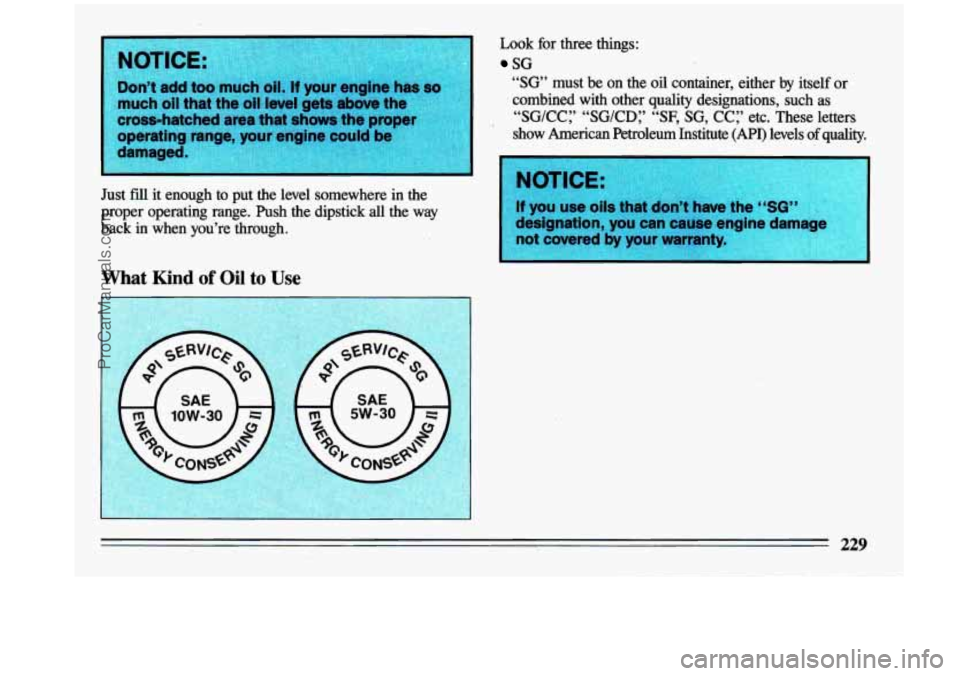
Just fd it enough to put the level somewhere in the
proper operating range. Push the dipstick all the way
back in when you’re through.
What Kind of Oil to Use
Look for three things:
SG
“SG”
must be on the oil container, either by itself or
combined with other quality designations, such as
“SG/CC:’ “SG/CD:’ “SF, SG, CC:’ etc. These letters
show American Petroleum Institute
(API) levels of quality.
229
ProCarManuals.com
Page 232 of 324
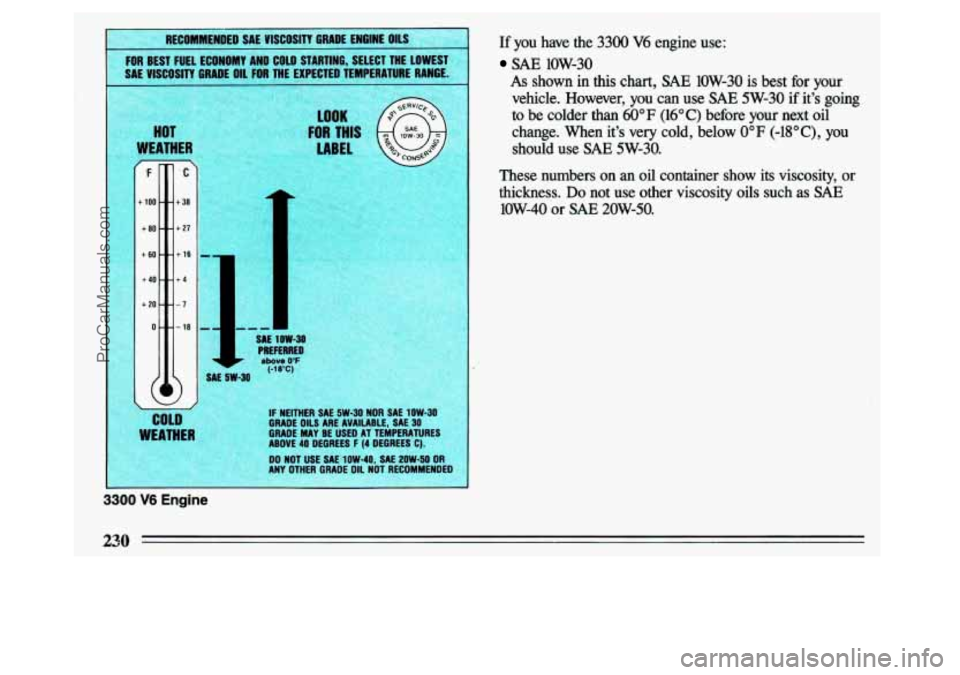
i
I ':
I 1
ISCOS E ENGINE OILS I '"'
FOR BEST FUEL ECONOMY AND COLD STARTING, SELECT THE LOWEST
I SAE VISCOSITY GRADE OIL FOR THE EXPECTED TEMPERATURE RANGE.
LOOK
LABEL
HOT FOR THIS WEATHER (
SAL 10W-3-
PREFERREl
AE 5W-30
COLD IF NEITHER SAE 5W-30 NOR SAE 1OW-30
GRADE OILS ARE AVAILABLE, SAE 30
ABOVE
40 DEGREES F (4 DEGREES C).
ANY OTHER GRADE OIL NOT RECOMMENDED WEATHER GRADE MAY BE USE0 AT TEMPERATURES
00 NOT USE SAE 1OW-40, SAE 2OW-50 OR
If you have the 3300 V6 engine use:
SAE 1OW-30
As shown in this chart, SAE 1OW-30 is best for your
vehicle. However, you can use
SAE 5W-30 if it's going
to
be colder than 60°F (16°C) before your next oil
change. When it's very cold, below 0°F (-18" C), you
should use
SAE 5W-30.
These numbers on an oil container show its viscosity, or
thickness.
Do not use other viscosity oils such as SAE
1OW-40 or SAE 20W-50.
ProCarManuals.com
Page 233 of 324
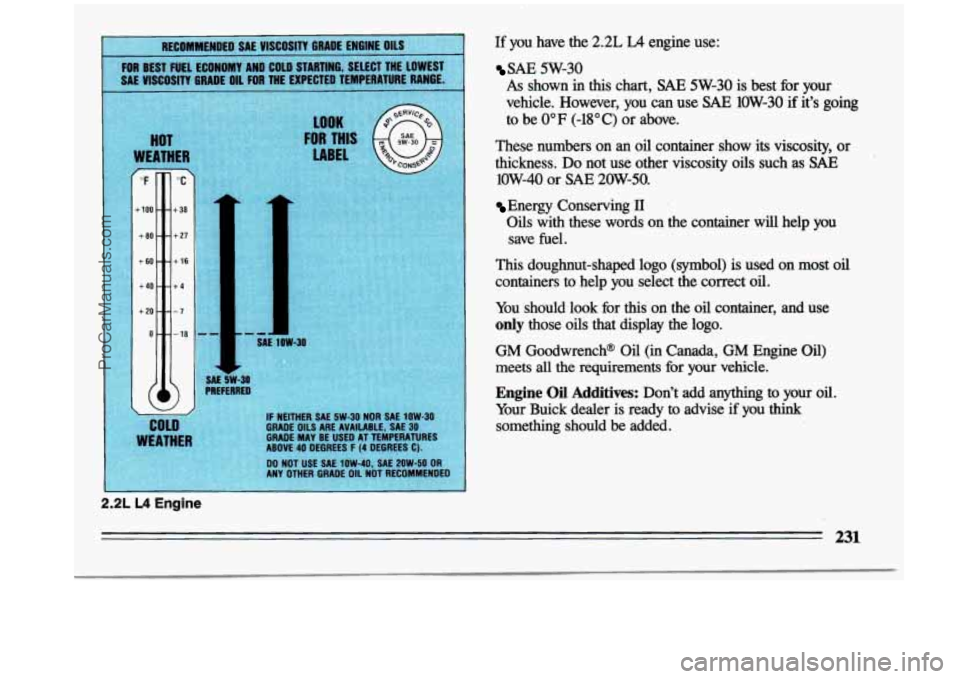
2.2L L4 Engine
LOOK
IR THI
LABEL
SAE 1OW-30
AE 5W-31 REFERREI
IF NEITHER SAE 5W-30 NOR SAE 1OW-30 GRADE OILS ARE AVAILABLE, SAE 30 GRADE MAY BE USE0 AT TEMPERATURES
ABOVE 40 DEGREES F (4 DEGREES C).
00 NOT USE SAE 1OW-40, SAE 2OW-50 Ofl ANY nTHFR CRAllF nll Nil1 RFfnMMFNnl
If you have the 2.2L LA engine use:
SAE 5W-30
As shown in this chart, SAE 5W-30 is best for your
vehicle. However, you can use
SAE 1OW-30 if it’s going
to be
0°F (-18°C) or above.
These numbers on
an oil container show its viscosity, or
thickness.
Do not use other viscosity oils such as SAE
low-40 or SAE 20W-50.
Energy Conserving II
Oils with these words on the container will help you save
fuel.
This doughnut-shaped logo (symbol) is used on most oil
containers to help you select the correct oil.
You should look for this on the oil container, and use
only those oils that display the logo.
GM Goodwrench@ Oil (in Canada, GM Engine Oil)
meets
all the requirements fix your vehicle.
Engine Oil Additives: Don’t add anything to your oil.
Your Buick dealer is ready to advise if you
think
something should be added.
231
ProCarManuals.com
Page 234 of 324
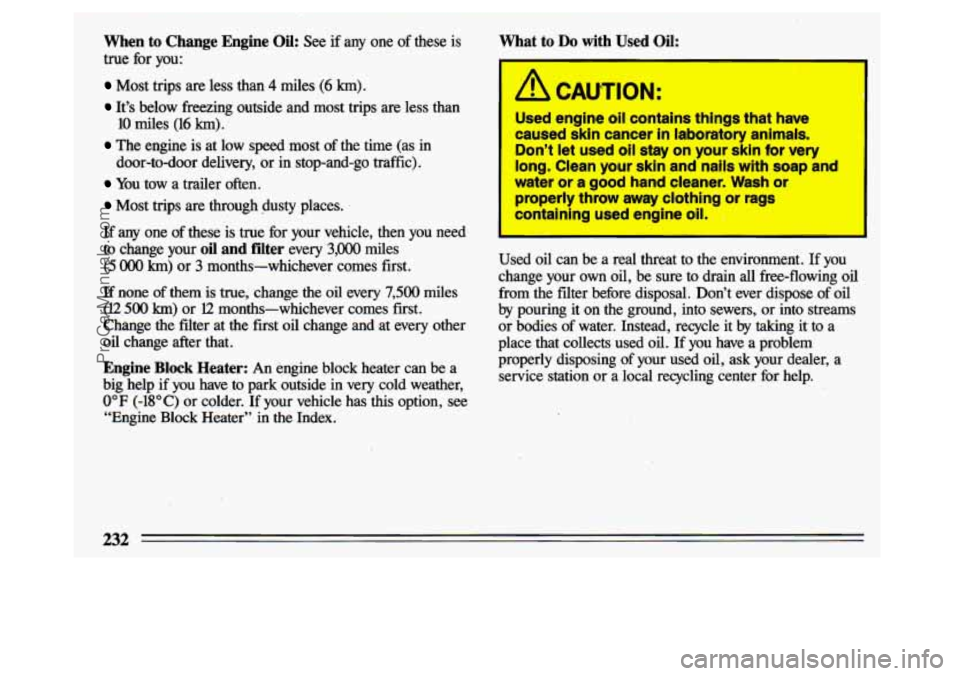
When to Change Engine Oil: See if any one of these is
true for you:
Most trips are less than 4 miles (6 km).
It’s below freezing outside and most trips are less than
10 miles (16 km).
The engine is at low speed most of the time (as in
door-to-door delivery,
or in stop-and-go traffic).
You tow a trailer often.
Most trips are through dusty places.
If any one of these is true for your vehicle, then you need
to change your oil and filter every 3,000 miles
(5 O00 km) or 3 months-whichever comes first.
If none
of them is true, change the oil every 7,500 miles
(12 500 km) or 12 months-whichever comes first.
Change the fdter at the first oil change and at every other
oil change afier that.
Engine Block Heater: An engine block heater can be a
big help if you have to park outside
in very cold weather,
0°F (-18°C) or colder. If your vehicle has this option, see
“Engine Block Heater”
in the Index.
What to Do with Used Oil:
-
/i CAUTION:
Used engine oil contains things that have
caused skin cancer in laboratory animals.
Don’t let used oil stay on your skin for very
long. Clean your skin and nails with soap and
water or a good hand cleaner. Wash or
properly throw away clothing or rags
containing used engine oil.
Used oil can be a real threat to the environment. If you
change your own oil, be sure to drain all free-flowing oil
from the filter before disposal. Don’t ever dispose of oil
by pouring it on the ground, into sewers, or into streams
or bodies of water. Instead, recycle it ‘by taking
it to a
place that collects used
oil. If you have a problem
properly disposing of your used oil, ask your dealer, a
service station or a local recycling center for help.
232
ProCarManuals.com
Page 235 of 324
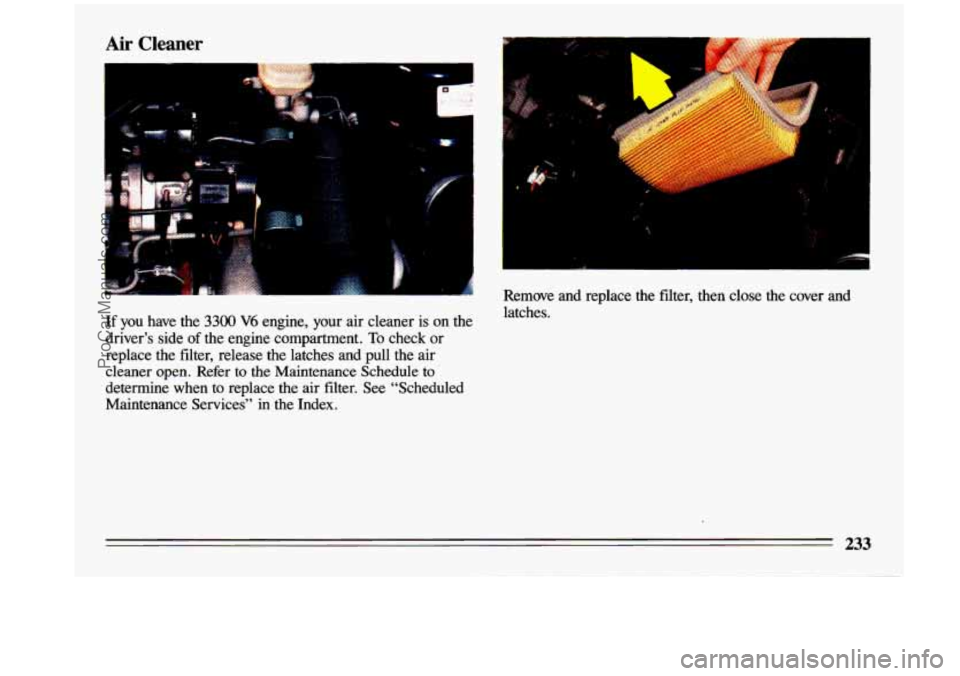
Air Cleaner
.-
If you have the 3300 V6 engine, your air cleaner is on the
driver’s side
of the engine compartment. To check or
replace the filter, release the latches and pull the air
cleaner open. Refer
to the Maintenance Schedule to
determine when to replace the air filter. See “Scheduled
Maintenance Services” in the Index.
I
Remove and replace the filter, then close the cover and
latches.
ProCarManuals.com
Page 236 of 324
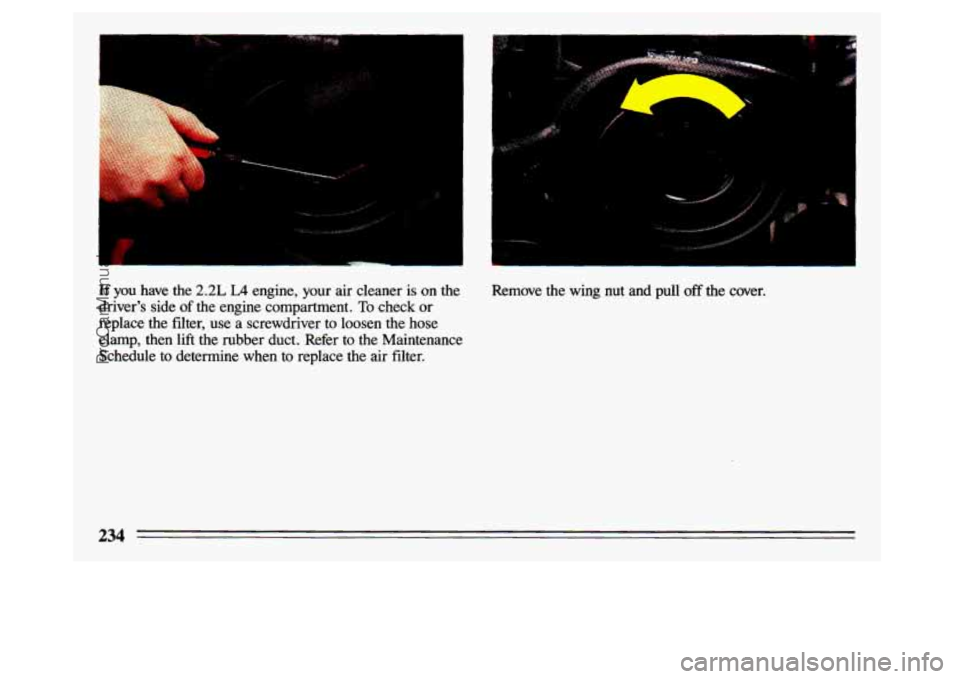
If you have the 2.2L L4 engine, your air cleaner is on the
driver's side
of the engine compartment. To check or
replace the filter, use a screwdriver to loosen the hose
clamp, then lift the rubber duct. Refer to the Maintenance Schedule to determine when to replace the air filter. Remove the wing nut and pull
off the cover.
234
ProCarManuals.com
Page 237 of 324
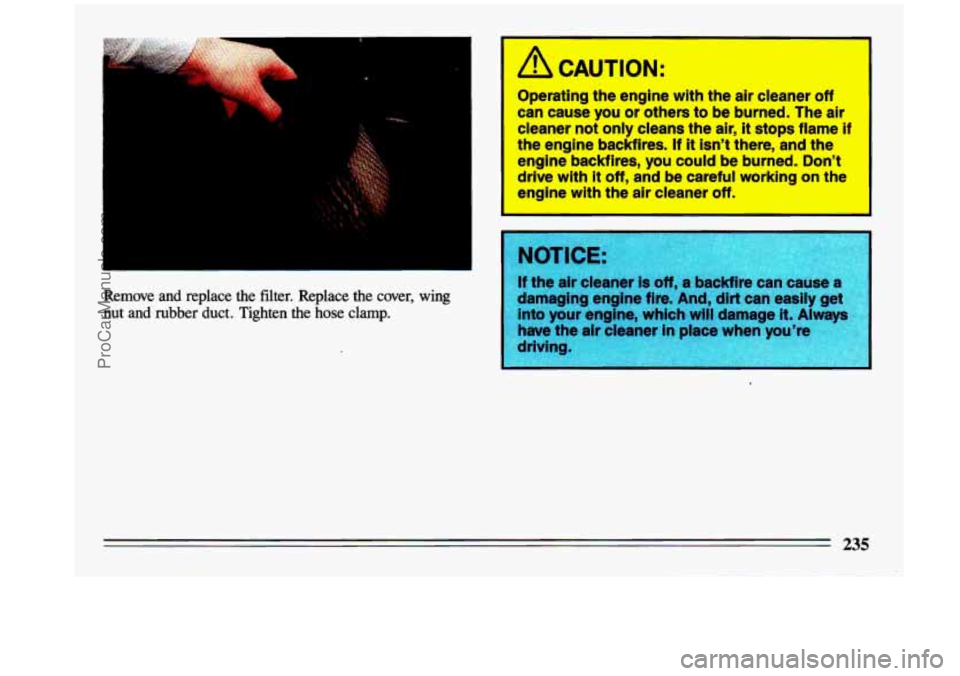
1
* *
Operating the engine with the air cleaner off
can cause you or others to be burned. The air
cleaner not only cleans the air,
it stops flame if
the engine backfires. If
it isn't there, and the
engine backfires, you could be burned. Don't
drive with
it off, and be careful working on the
engine with the air cleaner
off.
""a, i
NOTICE:
If the air cleaner is backfire- can ,cause a I
Remove and replace the filter. Replace the cover, wing
nut and rubber duct. Tighten
the hose clamp.
damaging engine fire. And, dirt can easily get
into vollr ennine, which
will damage it. Alwav I
havgtt
drivi
-r-
air ner in L)
235
~
ProCarManuals.com
Page 238 of 324
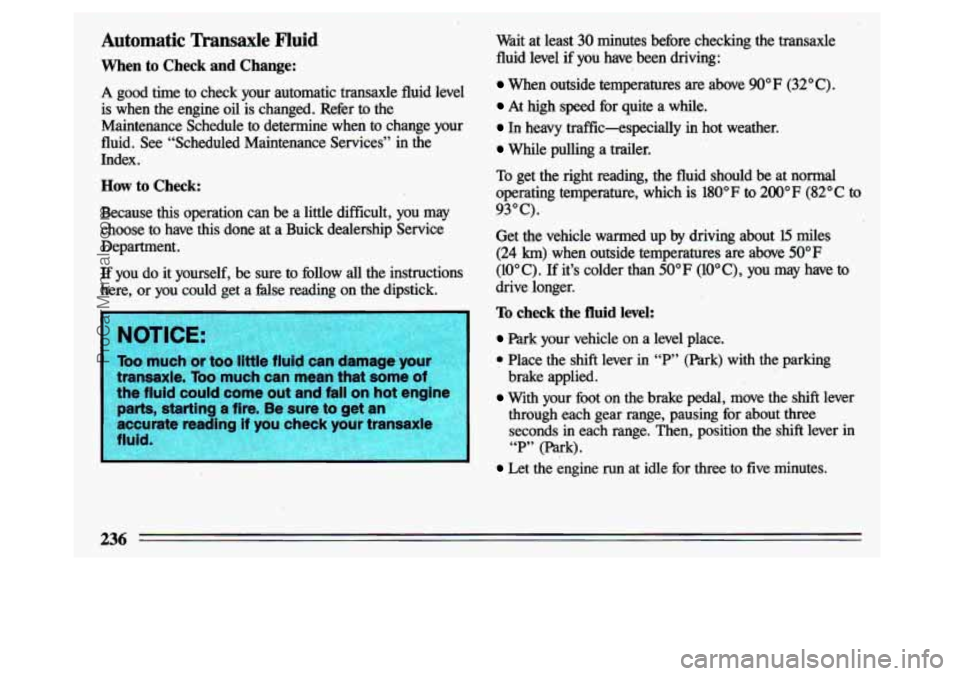
Automatic ‘mansaxle Fluid
When to Check and Change:
A good time to check your automatic transaxle fluid level
is when the engine oil is changed. Refer to the
Maintenance Schedule to determine when to change your
fluid. See “Scheduled Maintenance Services” in the
Index.
How to Check:
Because this operation can be a little difficult, you may
choose to have
this done at a Buick dealership Service
Department.
If you do it yourself, be sure to follow all the instructions
here, or you could get a false reading on the dipstick. Wait at least
30 minutes before checking the transaxle
fluid level
if you have been driving:
When outside temperatures are above 90°F (32°C).
At high speed for quite a while.
In heavy traffic-especially in hot weather.
While pulling a trailer.
To get the right reading, the fluid should be at normal
operating temperature, which is
180°F to 200” F (82” C to
93°C).
Get the vehicle warmed up by driving about 15 miles
(24 km) when outside temperatures are above 50°F
(10°C). If it’s colder than 50” F (lO°C), you may have to
drive longer.
To check the fluid level:
Park your vehicle on a level place.
0 Place the shift lever in “P” (Park) with the parking
brake applied.
With your foot on the brake pedal, move the. shift lever
through each gear range, pausing for about three
seconds in each range. Then, position the shift lever in
“P” (Park).
Let the engine run at idle for three to five minutes.
236
ProCarManuals.com
Page 239 of 324
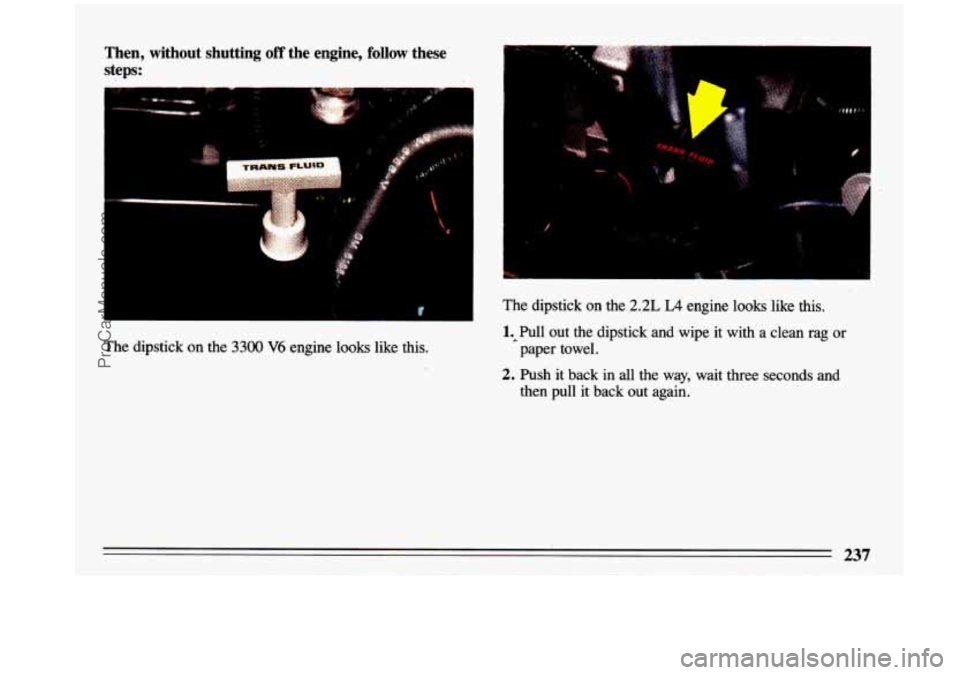
Then, without shutting off the engine, follow these
steps:
rhe dipstick on the 3300 V6 engine looks like this.
k
The dipstick on the 2.2L L4 engine looks like this.
1,Pull out the dipstick and wipe it with a clean rag
or
2. Push it back in all the way, wait three seconds and
paper towel.
then pull it back out again.
237
ProCarManuals.com
Page 240 of 324
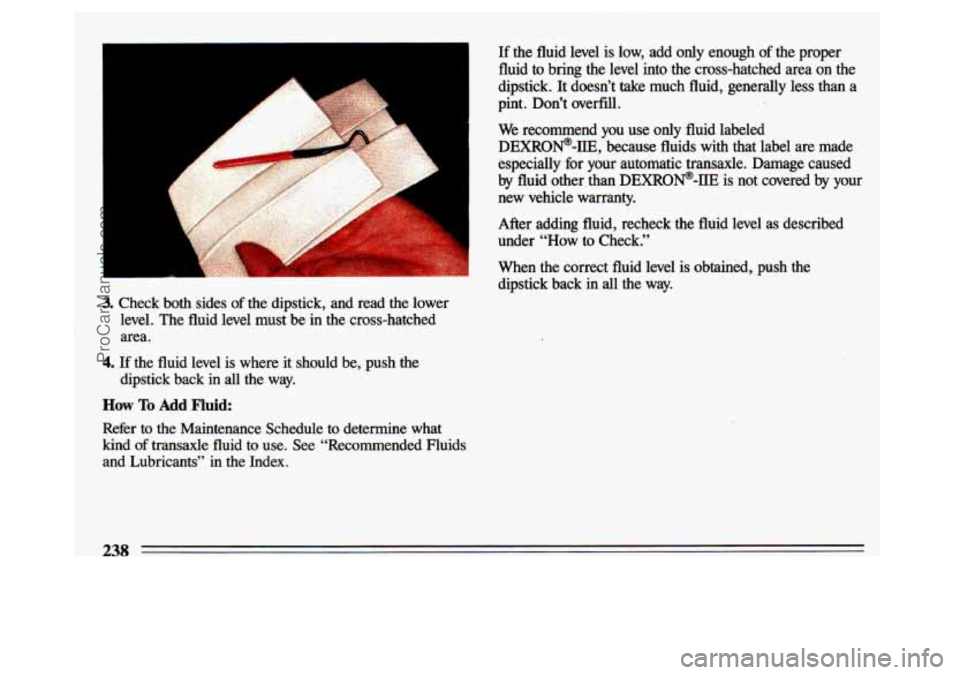
A
A
A
. .. 1
A
3. Check both sides of the dipstick, and read the lower
level. The fluid level must be
in the cross-hatched
area.
4. If the fluid level is where it should be, push the
dipstick back in all the way.
How To Add Fluid:
Refer to the Maintenance Schedule to determine what
kind of transaxle fluid
to use. See “Recommended Fluids
and Lubricants” in the Index.
If the fluid level is low, add only enough of the proper
fluid to bring the level into the cross-hatched area on the
dipstick. It doesn’t
take much fluid, generally less than a
pint. Don’t overfill.
We recommend you use only fluid labeled
DEXROP-IIE, because fluids with that label are made
especially for your automatic transaxle. Damage caused
by fluid other than DEXRON@-IIE is not covered by your
new vehicle warranty.
After adding fluid, recheck the fluid
level as described
under “How to Check.”
When the correct fluid level is obtained, push the
dipstick back in all the way.
238
ProCarManuals.com